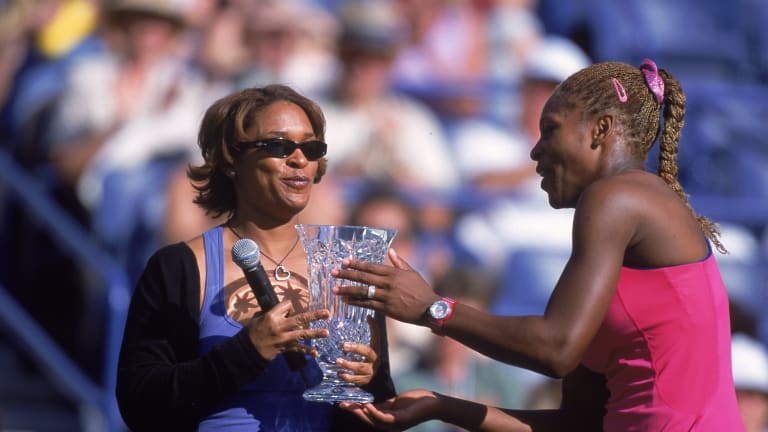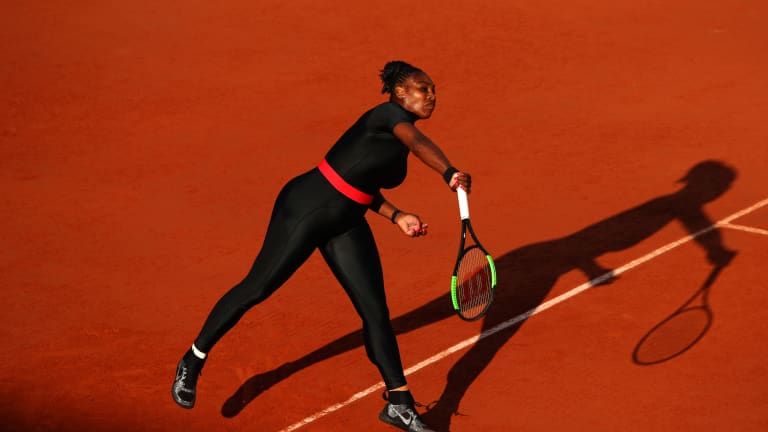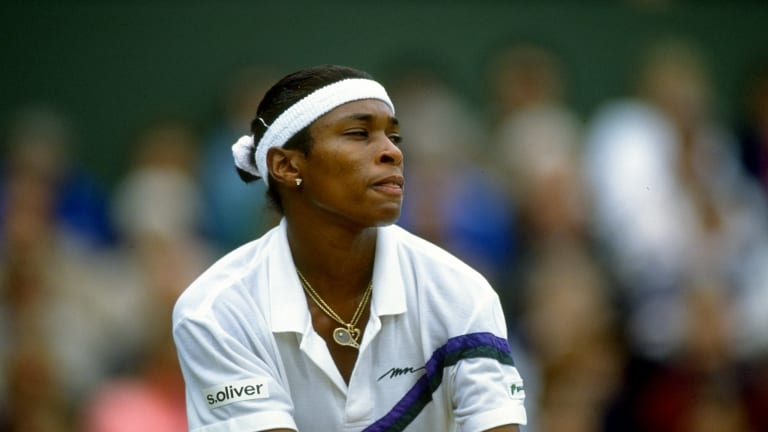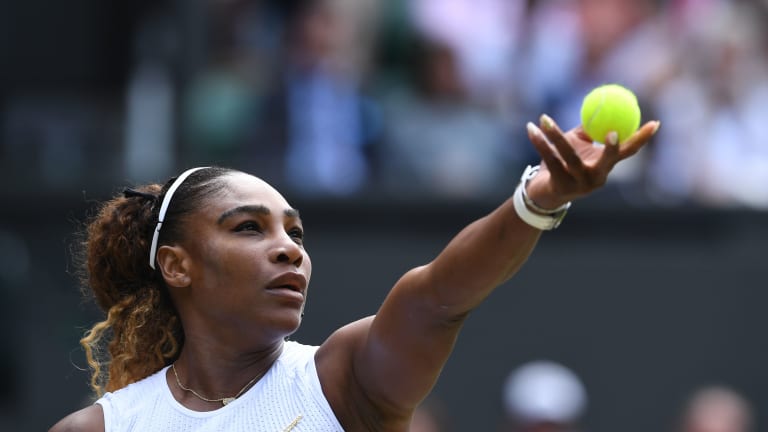Zina on Serena: Why I'm proud to have been along for the ride
By Zina Garrison Sep 03, 2022Gallery of Greatness: What Brady, Gretzky, Jordan, Joyner-Kersee, Vergeer and Serena have in common
By Joel Drucker Nov 25, 2022How soon could Serena Williams make a comeback?
By David Kane Oct 25, 2022The Matches that Made Serena the GOAT: Williams d. Venus Williams, 2017 Australian Open final
By Steve Tignor Oct 18, 2022The Matches that Made Serena the GOAT: Williams d. Maria Sharapova, 2012 Olympic gold medal match
By Steve Tignor Oct 18, 2022The Matches that Made Serena the GOAT: Williams d. Justine Henin, 2010 Australian Open final
By Steve Tignor Oct 15, 2022The Matches that Made Serena the GOAT: Williams d. Martina Hingis, 1999 US Open final
By Steve Tignor Oct 13, 2022The Matches that Made Serena the GOAT: Williams d. Steffi Graf, 1999 Indian Wells final
By Steve Tignor Oct 13, 2022WATCH: Serena Williams teases “Tom Brady”-style comeback on Good Morning America
By David Kane Sep 14, 2022Margaret Court and Serena Williams: A Comparative Discussion
By Joel Drucker Sep 13, 2022Zina on Serena: Why I'm proud to have been along for the ride
She was present from Day One, studiously skirting the spotlight as she earned the Williamses' trust. We asked Zina Garrison to write a reflection on her nearly lifelong relationship with Serena Williams, and she obliged.
Published Sep 03, 2022
Advertising
WATCH: Naomi Osaka speaks about on the impact Serena Williams has had on her
Many readers will recognize Zina Garrison as the first Black woman since Althea Gibson in 1956 to play a Grand Slam final. That was in 1990, at Wimbledon. A former world No. 1 junior, Garrison won, among other things, Olympic gold in doubles and a bronze in singles (both in Seoul in 1988), and 14 WTA singles titles over the course of her 15-year career, during which she reached a career-high ranking of No. 4.
What many people don’t know is that Garrison, now 58, has always been a significant presence in the lives of the Williams sisters, Venus and Serena. Garrison was one of the first—and few—people whom Richard Williams turned to for advice and help as he introduced the girls to tennis. Garrison was present from Day One, studiously skirting the spotlight as she earned the trust of the Williamses, not least because, as one family member put it, “Zina is always going to tell it like it is. She doesn’t care if you like it or not.”
Garrison still does some coaching, and she recently collaborated with Tennis Channel analyst Chanda Rubin—and numerous A-list guests—as a co-host on the multi-episode podcast, The Goat: Serena. We at TENNIS.com asked Zina to write a reflection on her nearly lifelong relationship with Serena, and she obliged. We hope you enjoy it.—Peter Bodo
Advertising

Zina Garrison and Serena Williams, at Indian Wells in 2001.
© Getty Images
The event was an exhibition and tennis clinic, sponsored by an anti-drug abuse program in Los Angeles in 1988. My friend Rosie Casals, a former pro star and one of the “Original 9” founders of the WTA, pulled me aside. She was excited, and said there was this super-talented kid I just had to see. This kid named Venus Williams.
But when I got to the court where the doubles match was going on, it was Venus’ partner who caught my eye. Although she was barely seven years old and her nose hardly reached above the net cord, Serena Williams was poaching returns, pumping her little fist, and high-fiving Venus.
I will never forget what I thought: “This little girl, she’s just got that fire.”
Now, 30-some-odd years and 23 Grand Slam singles titles later, Serena Williams is about to leave tennis behind. I followed her closely over those years, first as a mentor, sometimes as a coach, always as a friend and adviser with, I think, a voice she could trust to always tell her what I thought, and to give it to her straight.
Serena is leaving tennis in much better shape than it was in when she first appeared on the scene, where I dubbed her “the Little One” (a nickname I continued to use over the years). I feel privileged to have been a significant part of her life and career. I’m an introvert. I don’t crave attention. So I mostly stayed behind the curtain during Serena’s career. I was touched when Serena once described me as her “hidden treasure.”
Advertising
Why forgive? But that’s just what she did. After all those years, she simply said she forgives. . . I was like, “Who even does that?”
I admire many things about Serena, starting with that best-ever serve, and the way she went about putting her brand on the game. Most of all, though, I am in awe of her personal evolution. It was a journey of discovery and desire, fueled partly by her deep faith in God. It took Serena along many paths, from social justice to fashion. For me, the most memorable and powerful episode in her evolution occurred when she decided, in 2015, to return to play at Indian Wells—after having boycotted the event for 14 years due to an ugly, painful controversy.
I am a Black person. A Black woman, a Black woman tennis player, and even though I am a Christian I’m not sure I could have found it in my own heart to return to Indian Wells after the suspicion (of non-existent match-fixing), racism, and hate directed at the Williams family. By 2015, Serena was at the point in her life where she didn’t need to play that tournament. So why pick at old wounds? Why think about it, like she did, from a faith perspective? Why forgive? But that’s just what she did. After all those years, she simply said she forgives. . . I was like, “Who even does that?”
Serena does. It was part of the evolution I’ve been talking about.
Here are two keywords when it comes to Serena Williams: “trust” and “loyalty.” It was never easy to gain either of the sisters’ trust, partly because their father Richard was so protective. The girls had a lot of attention, and Richard knew the girls would face all the dangers that come with that from a young age. It didn’t matter that mother Oracene, the real rock in the family, repeatedly encouraged the girls to be strong, proud Black women.
A lot of people thought Richard Williams was crazy, but in a lot of ways that people didn’t always get, he was very smart—a perfect compliment to Oracene’s strength. He knew his girls were entering a world that has always been out of whack, foreign to a rising Black tennis athlete.
Advertising
The thing I’m most proud of about with Serena is the way she never allowed people to tear her down.
When I was learning the ropes as a pro, Arthur Ashe always made it a point to host a gathering of the African-American contingent at Wimbledon on the tournament’s Middle Sunday (until this year, there was no play on that day). It was nothing we ever publicized, but players, coaches, and even the few Black journalists on the tour were invited by word of mouth, come one, come all. This was basically a support system for us in the overwhelmingly white world of tennis.
When Arthur drew away from tennis due to his deteriorating health, his wife Jeanne called me to say that with Arthur gone, it was up to me to keep up certain traditions. I was stunned and flattered, but I told her, “I don’t want this, I’m an introvert and I don’t need this pressure.” But after we talked some more I took on the role. When Venus and Serena first came to one of those informal gatherings they got really excited to be around everyone, in a place where we could just be us, with others who looked like us, and not be looked upon or scrutinized because we were different, brown or Black.
One year during the Australian Open, Venus called to say that as their mom Oracene wasn’t going to be in Melbourne, would I make some of the soul food I was known for, some fried chicken and some greens? So I put together a group, including folks like Kamau Murray and Taylor Townsend. We didn’t expect Serena to attend because she was busy with the tournament, but when she walked in with Venus and saw our stunned expressions she said, “My mom normally does this, but there’s no way I’m missing it.”
Advertising

Garrison coached Williams as an important behind-the-scenes advisor, and as United States captain in Fed Cup (pictured here, in 2005).
© AFP via Getty Images
The social comfort zone for the girls in and out of tennis was pretty small at the start. One of my first, official turns as a “coach” to Serena was at the sisters’ Fed Cup (now the Billie Jean King Cup) debut. That was in an important semifinal in 1999, on red clay in Ancona, Italy. Little did we know that just weeks later, before Serena even turned 18, she would win her first major title at the US Open.
At the time, the girls were still living in the bubble created by Richard, who understandably trusted very few people. He told the girls in no uncertain terms not to speak to anyone except me, Lori McNeil (another player and often my doubles partner) and a select few others. Unfortunately, at the time Fed Cup captain Billie Jean King was not yet in that bubble, so I was brought in as an assistant coach, mainly to make sure the girls felt comfortable. Over the first few days, Venus and Serena must have asked me a hundred times, “Is Billie okay? Is Billie okay?” I was like, “Billie is fine, you can talk with Billie.”
The sisters began to trust Billie, but it was tricky territory. Richard was their primary coach. When other coaches asked the girls to do something, they might go through the motions, but they often weren’t really down for it because it didn’t come from Richard. Billie plowed on, though. She decided that both girls needed work on their cross-court backhands.
Billie put the sisters through a bunch of drills, really challenging them. The girls rose to the challenge. They wanted to stay on court as long as it took to prove that they could meet or surpass Billie’s expectations. It wasn’t certain that Serena would even get to play in that tie, because Venus and Monica Seles were penciled in for the singles. But when Monica got hurt in her first match. Serena was suddenly called upon to play the critical reverse singles, with the USA leading 2-1.
Serena won that match, clinching the tie with the cross-court backhand that she had worked so hard on in practice. She celebrated with a yell and a fist pump, then whirled to face Billie on the American bench. The grin on her face said, “How you like me now?
Advertising
Check it out it keeps getting better and better. The Goat Serena 😋 https://t.co/y7XGAtx36N
— Zina Garrison (@beyondthegold) October 21, 2021
The thing I’m most proud of about with Serena is the way she never allowed people to tear her down. She used criticism, or a challenge, as fuel. When you come after her, or try to tell her she can’t do something, or that it has to be done a certain, different way, it just makes her want to prove you wrong. It’s a great quality, but it also can work to her detriment. I think it showed in the way she’s been reluctant to call it a career at age 40, the way she chased that record-tying singles major No. 24. But that determination is also what enabled Serena to win numbers one to 23.
It’s also certain that Serena would not have been able to break as many barriers as she has without that determination. If she wanted to make a fashion statement—think “cat suit,” or “biker boots”—it was full speed ahead. Those outfits had just as much to do with pushback against the forces of tradition as they did with style. I was on the USTA board of directors at the time and, believe me, that group was very resistant to change and innovation. But here were these two Black girls and, on the men’s side, people like Andre Agassi, saying, “Hey, let’s open things up. Let’s do it!”
Put that attitude together with those electric, prime-time night match-ups at the US Open between Venus and Serena, or Andre and Pete (Sampras), and it was hard to argue for the status quo. They were sensational, headline-generating events, must-see television. That was just part of the way Serena refused to stay in the tennis lane. She, as well as Venus, cultivated outside interests. These kids weren’t afraid for their careers. They were like, “we could be this, we could be that, we could do anything and we can still do our tennis.”
The confidence to be that way came from Richard, who always predicted they would be well-rounded people. It was a self-fulfilling prophecy, a lot like his assumption that they would both be world No. 1s. “We heard that every day,” Venus once told me. “So we became No. 1 players because that’s what we were supposed to be.”
Advertising

Serena's groundbreaking outfits, like the "cat suit" at the 2018 French Open, had just as much to do with pushback against the forces of tradition as they did with style.
© 2018 Getty Images
The dramatic fashion statements brought a lot of attention to Serena’s body. Not all of it was positive or supportive. She was always muscular, and then as the years went on, she put on more mass. People started whispering about steroids, this and that. I had to laugh when people suggested that Serena’s bulk was a sign that she was out of shape, or soft, or not training enough. That was because I know her personal trainer, Mackie Shilstone.
A New Orleans base trainer and author, Mackie is an amazing, tough-as-nails motivator who trained and motivated Serena starting in 2007. Having been a trainer to, among others, Hall of Fame NFL quarterbacks, world champion prize fighters and special forces operatives, he brought a special, almost military-grade mindset and matching workout regimen into play. He also remained very much in the background as Serena’s haul of major titles grew.N
I got to know Mackie during the Covid lockdown. At one point early in the pandemic, Serena texted me to say, “Hey, what are you doing? Do you want to train?” I laughed, and texted back that I didn’t play tennis anymore. But she still wanted me to come down to her home in West Palm Beach, where she was training with Mackie. I agreed to go for a week after I got my second Covid shot. It ended up becoming a six-week visit.o
Advertising
Mackie specialized in helping people extend their careers. That made him especially valuable to Serena. But more than that, Serena holds Mackie in such high regard that he officiated at her wedding to Alexis Ohanian. It was an interesting choice, because things were changing in the Williams family. When Richard began to get sick, Serena probably needed a strong male—other than a husband—in her life. I think Mackie filled that role for her.
Mackie is honest, loyal and, like Serena, a person of faith. Like Oracene, he gives her strength—mental and emotional as well as physical. He is one of those people who seems to hold an interesting place in Serena’s life, someone she would always rely on or go back to, especially when she had questions. And if she wasn’t in the right place mentally to really hear what those people had to say, she listened anyway, because she knew they would always tell her the truth. M
I like to think I was one of those people, too. Serena is a person of complex emotions. She was selfish, but that comes with the territory for the best athletes in the world. At the same time, with the help of her faith, she evolved into a very caring, thoughtful person. That’s a very tough journey for a world-class athlete to take, but Serena did it. And I’m proud I was there to see it all happen.

